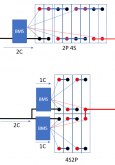Heard Will the other night discussing combining individual cells to make a large combined battery. The advice was to parallel the cells first, then put them in series. The problem I see with that is when using a BMS on each paralleled group, you can't have the BMS disconnect that group or else your .......let's say 24 V combined battery would become approx. 3.2 volts lower ( with one group disconnected by the BMS ). With a series then parallel arrangement, if one group gets disconnected, the combined battery voltage stays the same, but your capacity goes down. Only way around this issue for a parallel then series combined battery that I can see is to hook up a high amperage disconnect relay between the inverter / charger and the combined battery bank. Comments ?
Combining cells to make a large battery bank
- Thread starter Shazzam
- Start date



